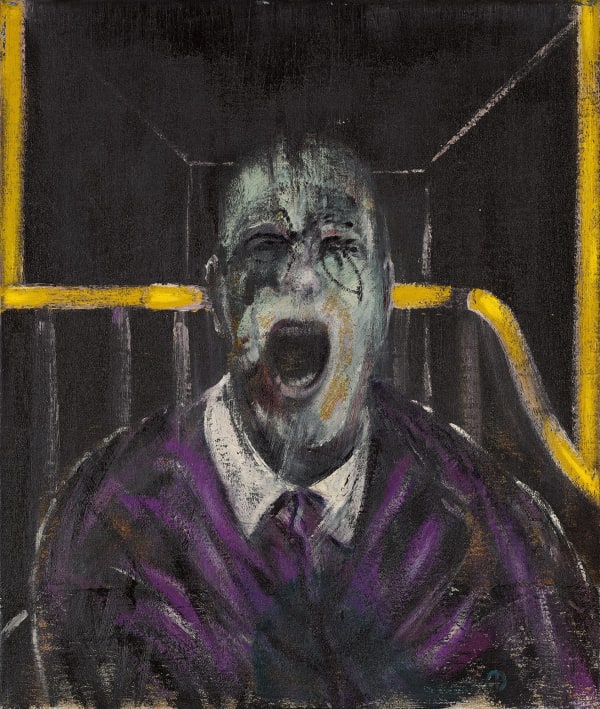-
Francis Bacon Prints For Sale.
Francis Bacon's art is a deep exploration of the human condition told through the revolutionary lens of a true genius. His distorted and contorted figures explore aspects religion, mythology & the deeply personal. Explore our latest Francis Bacon prints for sale at Guy Hepner, Bacon dealers since 2007.
Discover authentic Francis Bacon signed prints for sale below.
-
Works

Francis Bacon
Study For A Portrait of John Edwards, 1987Lithograph37 1/8 x 26 3/4 in
94 x 68 cmEdition of 180Copyright The ArtistFrancis Bacon’s Study for a Portrait of John Edwards is one of the most emotionally resonant works of the artist’s later years—a portrait that transcends traditional representation to become a...Francis Bacon’s Study for a Portrait of John Edwards is one of the most emotionally resonant works of the artist’s later years—a portrait that transcends traditional representation to become a meditation on intimacy, memory, and mortality. Created in 1986, this painting not only encapsulates Bacon’s mature artistic language but also stands as a tribute to the profound relationship he shared with John Edwards, his closest companion during the final decades of his life.Bacon met Edwards in 1974, at a time when the artist was emerging from a period of intense personal turmoil. Edwards, more than 40 years Bacon’s junior, provided a stabilizing presence and emotional equilibrium that sharply contrasted with the volatile and often destructive relationships of Bacon’s past. While their bond was platonic, it was deeply affectionate and enduring—marked by trust, companionship, and mutual understanding. Study for a Portrait of John Edwards reflects this connection with remarkable tenderness and restraint, revealing a softer side of Bacon that rarely emerged so clearly in his earlier portraits.The portrait depicts Edwards standing nude within a sparse, architectural space, a familiar visual strategy in Bacon’s late compositions. The geometric austerity of the room—a darkened doorway, pale floor, and stark walls—creates an atmosphere of existential introspection. The figure appears subtly detached from his surroundings, as though suspended in a liminal realm between presence and absence. This sense of spatial dislocation, accentuated by the slightly cut-out appearance of the figure, imparts a dreamlike quality to the scene, echoing the fragmented, layered nature of memory and psychological perception.The composition’s emotional resonance is heightened by one of its most striking features: the sharply rendered shadow cast by Edwards on the floor. This shadow is almost sculptural in presence—solid, weighted, and deliberate—acting not just as a visual anchor but as a metaphysical echo of the figure. It suggests the inescapability of mortality, the doubling of the self, and the fleeting imprint we leave behind. Bacon reinforces this idea with a rectangular form outlined on the floor, as if to frame or contain the figure within a metaphysical space. It is a subtle yet powerful gesture, hinting at the boundaries of life, memory, and physical existence.While Bacon had long abandoned painting from life, he relied on photography as a critical tool in his practice. Edwards, in fact, played an essential role in this process—often photographing Bacon himself, and in turn becoming a frequent subject of Bacon’s painted portraits. The use of photographs allowed Bacon to distance himself from the immediate presence of the sitter, enabling a degree of emotional and aesthetic manipulation. In Study for a Portrait of John Edwards, the image becomes a synthesis of visual memory, emotional truth, and creative interpretation. Edwards is not depicted with psychological torment or anatomical violence; instead, he is rendered with quiet dignity, stillness, and an almost meditative grace.This portrait is particularly significant within the arc of Bacon’s career. By the mid-1980s, the artist had refined his approach into something leaner, more focused, and less overtly brutal. His earlier works often throbbed with anguish—figures twisted in existential agony, faces howling with internal torment. In contrast, Study for a Portrait of John Edwards is marked by calmness and clarity. The restrained palette of warm greys, flesh tones, and muted architectural blues further emphasizes the work’s contemplative mood. There is no overt violence here—only an atmosphere of profound introspection.Yet, the specter of mortality remains. The darkened doorway behind Edwards operates on both a literal and symbolic level. It suggests the passage of time, the approach of death, the threshold between being and non-being. Like so many of Bacon’s spatial constructions, it opens into nothingness—both a void and a metaphor for the unknown. But unlike the more menacing voids of his earlier work, this threshold feels quieter, more resolved. There is still tension, but also acceptance.In Study for a Portrait of John Edwards, Bacon reaches a rare moment of equilibrium—a reconciliation, however temporary, between the violence of existence and the solace of connection. The painting is not just a depiction of Edwards, but a reflection of Bacon himself: older, more introspective, and acutely aware of the impermanence of life. It serves as both personal homage and universal meditation—on love, on presence, and on the traces we leave behind.Ultimately, this work stands as one of the most poignant statements of Bacon’s late period. It distills decades of exploration into form, flesh, and psychology into a single image that is at once restrained and deeply emotive. Through minimal means—geometry, shadow, subtle distortion—Bacon expresses the quiet profundity of human connection, and the inevitable passage of time that gives it meaning.For more information on Study for a Portrait of John Edwards or to buy Study for a Portrait of John Edwards contact our galleries using the form below.Overview"The job of the artist is always to deepen the mystery".
Francis Bacon is one of the most important artists of the 20th century and post-war movements. Arguably one of the finest and most celebrated artists of his generation, Bacon holds a pivotal role in contemporary art through his revolutionary approach to his craft. One of the great explorers of the human condition Francis Bacon and his art, touch on fateful mix of mythology, religion, love and death, and document our joys, sorrows and pains perhaps better than any other artist before or since.
The imagery of Bacon is one of pure expression rejecting the prevailing artistic style of abstraction of the era, in favor of a distinctive and disturbing realism and his distorted forms convey a sense of both beauty and despair. The dichotomy in Bacon’s prints and imagery can be seen through his raw use of violent, yet delicate colors as well as the marriage he makes between the figurative and abstract. It is this soft balance between the brutal and the subtle, the violent and the soft and happiness and anguish that make Francis Bacon’s art so important and collectible. A master of painting, and known for his large scale canvases, Bacon combines seemingly disparate tectures, colours and forms to ceate a whirlwind of emotion conveying and reaching the heart of his subjective matter. Equally so Franci Bacon's print output, often as apres, lithographs or signed prints, offer his most popular subjects including Pope Francis and his famous triptychs.
Whether new to collecting Francis Bacon prints or an experienced collector, Guy Hepner can help. Since 2007 we have assisted clients across the world to buy Francis Bacon prints in confidence. Whether iconic triptych, lithographs or apres, our experienced and knowledgeable team are on hand to help you achieve your collecting goals. From our New York and London galleries, offer a wide selection of authentic Francis Bacon prints for sale.
Contact info@guyhepner.com for our latest Francis Bacon prints for sale or to buy Francis Bacon original art. News
News-

London’s Frieze Week Record Breakers
A Guide to a Blockbuster Week of Sales October 20, 2025London’s marquee auction houses just concluded a blockbuster week of contemporary art sales, coinciding with the Frieze art fair. In a series of evening auctions...Read more -

A Collector’s Guide to Francis Bacon Prints
Why Collect Bacon March 14, 2025Francis Bacon remains one of the most powerful and influential artists of the 20th century. His raw, visceral works depicting the human form in distorted,...Read more




